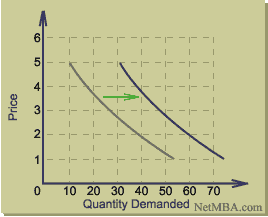Economics > Demand Curve
The Demand Curve
The quantity demanded of a good usually is a strong function of its price. Suppose an experiment is run to determine the quantity demanded of a particular product at different price levels, holding everything else constant. Presenting the data in tabular form would result in a demand schedule, an example of which is shown below.
Demand Schedule
Price |
Quantity |
5 |
10 |
4 |
17 |
3 |
26 |
2 |
38 |
1 |
53 |
The demand curve for this example is obtained by plotting the data:
Demand Curve

By convention, the demand curve displays quantity demanded as the independent variable (the x axis) and price as the dependent variable (the y axis).
The law of demand states that quantity demanded moves in the opposite direction of price (all other things held constant), and this effect is observed in the downward slope of the demand curve.
For basic analysis, the demand curve often is approximated as a straight line. A demand function can be written to describe the demand curve. Demand functions for a straight-line demand curve take the following form:
Quantity = a - (b x Price)
where a and b are constants that must be determined for each particular demand curve.
When price changes, the result is a change in quantity demanded as one moves along the demand curve.
Shifts in the Demand Curve
When there is a change in an influencing factor other than price, there may be a shift in the demand curve to the left or to the right, as the quantity demanded increases or decreases at a given price. For example, if there is a positive news report about the product, the quantity demanded at each price may increase, as demonstrated by the demand curve shifting to the right:
Demand Curve Shift

A number of factors may influence the demand for a product, and changes in one or more of those factors may cause a shift in the demand curve. Some of these demand-shifting factors are:
Customer preference
Prices of related goods
Complements - an increase in the price of a complement reduces demand, shifting the demand curve to the left.
Substitutes - an increase in the price of a substitute product increases demand, shifting the demand curve to the right.
Income - an increase in income shifts the demand curve of normal goods to the right.
Number of potential buyers - an increase in population or market size shifts the demand curve to the right.
Expectations of a price change - a news report predicting higher prices in the future can increase the current demand as customers increase the quantity they purchase in anticipation of the price change.
Economics > Demand Curve


